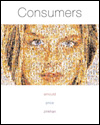This chapter explores a number of behaviors related to acquisition of goods
and services. Acquisition is a general consumer behavior concept. Marketers
tend to focus their attention on impersonal marketplace exchanges that we call
purchase behavior. Purchase is the outcome of an array of other behaviors, and
is often only an incidental part of these behaviors. Acquisition may involve
goods and services, but it may not involve money; this leads to a discussion
of countertrade. In gift-giving behaviors, goods or services obtained are de-emphasized
in favor of the relational meanings or feelings they evoke. To provide a framework for understanding these diverse consumer acquisition
behaviors, we outline Homan's exchange model, which contains five complementary
perspectives. First, we discuss purchase behavior. We discuss some of the types
of decisions consumers must make, and review some basic models of purchase decisions.
We also spend some time discussing impulse purchases that conform poorly to
standard decision-making models of purchase behavior. The basic models of purchase
behavior employed in consumer research include the utilitarian, decision-making,
behavioral influence, hedonic, and meaning transfer practices. We review countertrade, indentifying the four main types of countertrade and
their significance for business-to-business acquisition behaviors and position
countertrade on Homan's exchange continuum. We also offer a brief glimpse of
an interesting trend towards consumer-initiated barter systems. The final section of the chapter discusses gift-giving. We position gift-giving
on Homan's exchange continuum and identify the cultural roots of gift giving.
We discuss two types of gifts, interpersonal gifts and self-gifts. We indicate
how structural and emergent occasions may provoke gift-giving. We discuss how
managers may influence gift giving purchases and design retail environments
to encourage gift purchases. | 



 2002 McGraw-Hill Higher Education
2002 McGraw-Hill Higher Education


 2002 McGraw-Hill Higher Education
2002 McGraw-Hill Higher Education